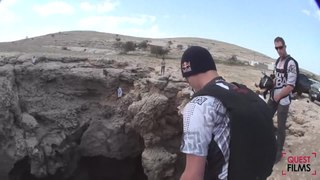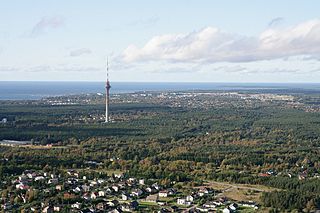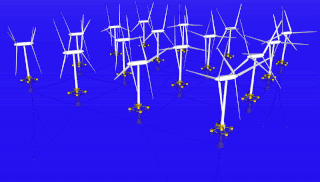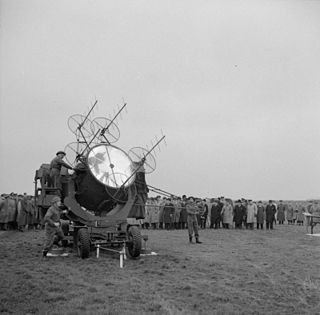
BASE jumping is the recreational sport of jumping from fixed objects, using a parachute to descend safely to the ground. "BASE" is an acronym that stands for four categories of fixed objects from which one can jump: buildings, antennae, spans (bridges), and earth (cliffs). Participants exit from a fixed object such as a cliff, and after an optional freefall delay, deploy a parachute to slow their descent and land. A popular form of BASE jumping is wingsuit BASE jumping.

Tsing Ma Bridge is a bridge in Hong Kong. It is the world's 16th-longest span suspension bridge, and was the second longest at time of completion. The bridge was named after the two islands it connects, namely Tsing Yi and Ma Wan. It has two decks and carries both road and rail traffic, which also makes it the largest suspension bridge of this type. The bridge has a main span of 1,377 metres (4,518 ft) and a height of 206 metres (676 ft). The span is the longest of all bridges in the world carrying rail traffic.

Chain Home, or CH for short, was the codename for the ring of coastal early warning radar stations built by the Royal Air Force (RAF) before and during the Second World War to detect and track aircraft. Initially known as RDF, and given the official name Air Ministry Experimental Station Type 1 in 1940, the radar units were also known as Chain Home for most of their life. Chain Home was the first early warning radar network in the world and the first military radar system to reach operational status. Its effect on the war made it one of the most powerful weapons of what became known as the "Wizard War".

Near-field communication (NFC) is a set of communication protocols that enables communication between two electronic devices over a distance of 4 cm (1.57 in) or less. NFC offers a low-speed connection through a simple setup that can be used to bootstrap more capable wireless connections. Like other "proximity card" technologies, NFC is based on inductive coupling between two antennas present on NFC-enabled devices—for example a smartphone and a printer—communicating in one or both directions, using a frequency of 13.56 MHz in the globally available unlicensed radio frequency ISM band using the ISO/IEC 18000-3 air interface standard at data rates ranging from 106 to 848 kbit/s.

Tallinn TV Tower is a free-standing structure with an observation deck, built to provide better telecommunication services for the 1980 Moscow Summer Olympics regatta event. It is located near the suburb Pirita, six km north-east of the Tallinn city center. With its 313 m (1030.2 ft), the TV tower is the tallest nonbuilding structure in Tallinn. The tower was officially opened on 11 July 1980. The viewing platform at a height of 170 metres was open to the public until 26 November 2007, when it was closed for renovation. The tower began receiving visitors again on 5 April 2012. The building is administered by the public company Levira and is a member of the World Federation of Great Towers.

A cell site, cell phone tower, cell base tower, or cellular base station is a cellular-enabled mobile device site where antennas and electronic communications equipment are placed to create a cell, or adjacent cells, in a cellular network. The raised structure typically supports antenna and one or more sets of transmitter/receivers transceivers, digital signal processors, control electronics, a GPS receiver for timing, primary and backup electrical power sources, and sheltering.

A transmission tower is a tall structure, usually a lattice tower made of steel that is used to support an overhead power line. In electrical grids, transmission towers carry high-voltage transmission lines that transport bulk electric power from generating stations to electrical substations, from which electricity is delivered to end consumers; moreover, utility poles are used to support lower-voltage sub-transmission and distribution lines that transport electricity from substations to electricity customers.

A guyed mast or guyed tower is a tall thin vertical structure that depends on guy lines for stability. The mast itself has the compressive strength to support its own weight, but does not have the shear strength to stand unsupported. It requires guy lines to stay upright and to resist lateral forces such as wind loads. Guy lines are usually spaced at equal angles about the structure's base.

A guy-wire, guy-line, guy-rope, down guy, or stay, also called simply a guy, is a tensioned cable designed to add stability to a free-standing structure. They are used commonly for ship masts, radio masts, wind turbines, utility poles, and tents. A thin vertical mast supported by guy wires is called a guyed mast. Structures that support antennas are frequently of a lattice construction and are called "towers". One end of the guy is attached to the structure, and the other is anchored to the ground at some distance from the mast or tower base. The tension in the diagonal guy-wire, combined with the compression and buckling strength of the structure, allows the structure to withstand lateral loads such as wind or the weight of cantilevered structures. They are installed radially, usually at equal angles about the structure, in trios and quads. As the tower leans a bit due to the wind force, the increased guy tension is resolved into a compression force in the tower or mast and a lateral force that resists the wind load. For example, antenna masts are often held up by three guy-wires at 120° angles. Structures with predictable lateral loads, such as electrical utility poles, may require only a single guy-wire to offset the lateral pull of the electrical wires, at a spot where the wires change direction.

A utility pole is a column or post usually made out of wood used to support overhead power lines and various other public utilities, such as electrical cable, fiber optic cable, and related equipment such as transformers and street lights. It can be referred to as a transmission pole, telephone pole, telecommunication pole, power pole, hydro pole, telegraph pole, or telegraph post, depending on its application. A Stobie pole is a multi-purpose pole made of two steel joists held apart by a slab of concrete in the middle, generally found in South Australia.
Radio masts and towers are typically tall structures designed to support antennas for telecommunications and broadcasting, including television. There are two main types: guyed and self-supporting structures. They are among the tallest human-made structures. Masts are often named after the broadcasting organizations that originally built them or currently use them.

An airborne wind turbine is a design concept for a wind turbine with a rotor supported in the air without a tower, thus benefiting from the higher velocity and persistence of wind at high altitudes, while avoiding the expense of tower construction, or the need for slip rings or yaw mechanism. An electrical generator may be on the ground or airborne. Challenges include safely suspending and maintaining turbines hundreds of meters off the ground in high winds and storms, transferring the harvested and/or generated power back to earth, and interference with aviation.

Space-based solar power is the concept of collecting solar power in outer space with solar power satellites (SPS) and distributing it to Earth. Its advantages include a higher collection of energy due to the lack of reflection and absorption by the atmosphere, the possibility of very little night, and a better ability to orient to face the Sun. Space-based solar power systems convert sunlight to some other form of energy which can be transmitted through the atmosphere to receivers on the Earth's surface.

Unconventional wind turbines are those that differ significantly from the most common types in use.
High-definition television (HDTV) describes a television or video system which provides a substantially higher image resolution than the previous generation of technologies. The term has been used since at least 1933; in more recent times, it refers to the generation following standard-definition television (SDTV). It is the current de facto standard video format used in most broadcasts: terrestrial broadcast television, cable television, satellite television.

Mobile cell sites are infrastructures transportable on trucks, allowing fast and easy installation in restricted spaces. Their use is strategic for the rapid expansion of cellular networks putting into service point-to-point radio connections as well as supporting sudden increases in mobile traffic in the case of extraordinary events. Mobile cell sites are also used by law enforcement organizations to gather intelligence. Mobile cell sites require neither civil works nor foundations, just minimal requirements like commercial power and grounding. The mobile units have been designed to be a temporary solution, but if requested, they can be transformed into permanent stations.
Blue Joker was an experimental moored balloon-mounted, airborne early-warning radar project developed by the Royal Radar Establishment (RRE) starting in 1953. The idea was to position the radar high in the air in order to extend its radar horizon and allow it to see low-flying aircraft. Ground reflections were filtered out using a moving target indicator (MTI) system. Two examples were built and tested in the late 1950s, but the project was cancelled in 1960 as part of the Linesman/Mediator efforts.

The Type 277 was a surface search and secondary aircraft early warning radar used by the Royal Navy and allies during World War II and the post-war era. It was a major update of the earlier Type 271 radar, offering much more power, better signal processing, new displays, and new antennas with greatly improved performance and much simpler mounting requirements. It allowed a radar with performance formerly found only on cruisers and battleships to be fitted even to the smallest corvettes. It began to replace the 271 in 1943 and was widespread by the end of the year.

Searchlight Control, SLC for short but nicknamed "Elsie", was a British Army VHF-band radar system that provided aiming guidance to an attached searchlight. By combining a searchlight with a radar, the radar did not have to be particularly accurate, it only had to be good enough to get the searchlight beam on the target. Once the target was lit, normal optical instruments could be used to guide the associated anti-aircraft artillery. This allowed the radar to be much smaller, simpler and less expensive than a system with enough accuracy to directly aim the guns, like the large and complex GL Mk. II radar. In 1943 the system was officially designated Radar, AA, No. 2, although this name is rarely used.















